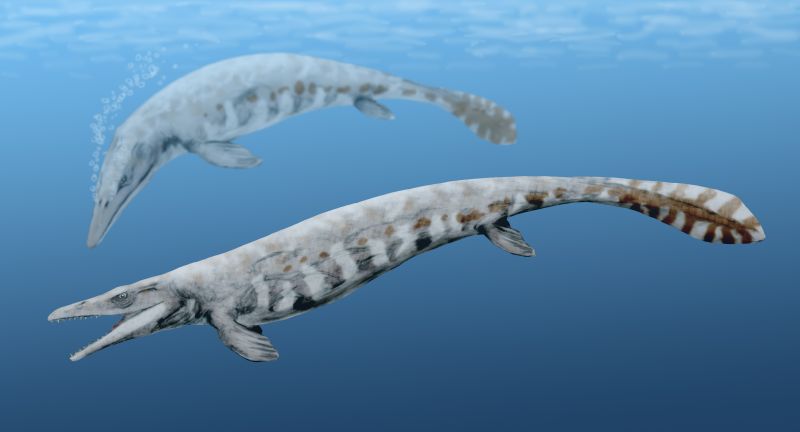- Halisaurinae
Taxobox
name = Halisaurinae
fossil_range =Late Cretaceous

image_width = 250px
image_caption = "Halisaurus "
regnum =Animal ia
phylum = Chordata
classis =Sauropsid a
subordo =Scleroglossa
infraordo =Anguimorpha
familia =Mosasauridae
subfamilia = Halisaurinae
subfamilia_authority = Bardet et al.,2005 Bardet N, Suberbiola XP, Iarochene M, Bouyahyaoui F, Bouya B, Amaghzaz M. 2005. A new species of "Halisaurus" from the Late Cretaceous phosphates of Morocco, and the phylogenetical relationships of the Halisaurinae (Squamata: Mosasauridae). "Zoological Journal of the Linnean Society" 143: 447-472.]
subdivision_ranks = Genera
subdivision =
* "Eonatator "
* "Halisaurus "Halisaurinae is asubfamily ofmosasaur s, a diverse group of LateCretaceous marinesquamate s.Bardet et al. (2005, p. 464) diagnosed the Halsaurinae as all mosasaurs more closely related to "Halisaurus" than "Moanasaurus". Unambiguous character states were listed as follows: "
premaxilla -maxilla sutural contact vertical anteriorly, oblique at midpoint and horizontal posteriorly; contact plane between theparietal and the supratemporal oblique; preaxial ridge extending on two-thirds of the length of the radius;tibia andfibula long and slender with slightly expanded extremities. Ambiguous characters include "dorsal median ridge borne on the anterior two-thirds of thefrontal ; frontal withventral boss; parietal foramen surrounded by a ventral boss;quadrate with large infrastapedial process; coalescent infra- and suprastapedial processes of quadrate;zygosphene -zygantrum complex absent;synapophyses of thecervical vertebra e extending ventrally to the ventral surface of the centrum; fusedhaemal spine s."Designation of this subfamily followed many decades of confusion surrounding the
type genus , "Halisaurus," especially "H. sternbergii", a species from the MoorevilleChalk ofAlabama and the Niobrara Chalk ofKansas . Originally, thespecies had been referred to the mosasaurine "Clidastes" Wiman CJ. 1920. Some reptiles from the Niobrara group in Kansas. "Bulletin of the Geological Institute of Uppsala" 18: 9-18 (9 figs., pls. II-IV).] , then to "Halisaurus" (Russell, 1967; p. 369 Russell DA. 1967. Systematics and morphology of American mosasaurs. "Peabody Museum of Natural History, Yale University, Bulletin" 23.] ), which was also considered a member of theMosasaurinae at that time. Later workers Wright KR. 1988. A new specimen of "Halisaurus platyspondylus" (Squamata: Mosasauridae) from the Navesink Formation (Maastrichtian) of New Jersey. "Journal of Vertebrate Paleontology" 8 (Supplement 3): 29A-30A.] Bell GL. Jr. 1997. A phylogenetic revision of North American and Adriatic Mosasauroidea. pp. 293-332 In: Callaway JM. and Nicholls EL, (eds.), "Ancient Marine Reptiles", Academic Press: 501 pp.] questioned thephylogenetic position andmonophyly of "Halisaurus", in part because of striking morphological differences between "H. sternbergii" and the other known species of thetaxon . Finally, Bardet et al. (2004) determined that "H. sternbergii" was notconspecific with the other members of thegenus and erected a new genus, "Eonatator ", as well a new new subfamily, consisting of "Eonatator" and "Halisaurus". Halisaurines (as members of this subfamily are collectively and informally known) were small to medium-sized mosasaurs averaging 4.5-6+ meters in length. Of all known mosasaurids, they were the least adapted to a marine lifestyle. Halisaurines are known fromNorth America ,Europe ,South America , andAfrica . The earliest known remains of halisaurines occur in rocks ofSantonian age and the subfamily persists until the latestMaastrichtian . Theetymology of this group derives from the genus "Halisaurus" (Greek "halis" = "sea" + Greek "sauros" = "lizard").Phylogeny and Taxonomy
"Halisaurus" is an important taxon in studies of mosasaur
phylogeny as it has been repeatedly considered thesister group to all other mosasaurs. Acladistic analysis by Bardet et al. (2005, p. 462-463 ) supported this model and theclade composed of "Halisaurus " and "Eonatator " was christened the Halisaurinae, "the sister group of more advanced mosasaurids."*Halisaurinae
**"Halisaurus "
***"H. platyspondylus"
***"H. ortlebi"
***"H. arambourgi"
***"H. onchognathus" ("nomen dubium "; holotype destroyed duringWorld War II )
**"Eonatator "
***"E. sternbergii"References
Further reading
Bardet N, Suberbiola XP. 2001. The basal mosasaurid "Halisaurus sternbergii" from the Late Cretaceous of Kansas (North America): a review of the Uppsala type specimen. "Comptes Rendus de l'Academie des Sciences - Series IIA - Earth and Planetary Science" 332: 395-402.
External links
* [http://www.oceansofkansas.com/Halisaurus.html Oceans of Kansas' "Kansas Mosasaurs in Sweden" page, devoted to the holotype of "Halisaurus sternbergii", includes many photos]
Wikimedia Foundation. 2010.
